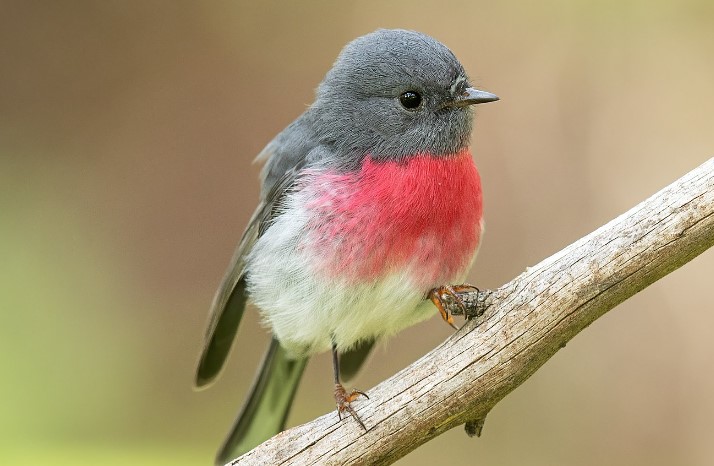The Grey Goshawk (Accipiter novaehollandiae) is a bold and persistent hunter, flying directly in pursuit of prey. A sudden attack at a speed that catches unwary birds by surprise or ambushes them Prey includes small birds, mammals as large as rabbits, reptiles, grasshoppers, cicadas, beetles, and other insects. Females are larger than males and are capable of taking larger prey. In addition to attacks on the ground and in the air, the birds also chase their victims into dense undergrowth in order to capture them.
Their grey-white tones, broadly rounded wings, and long, rounded tails readily distinguish them when they soar to great heights, particularly during circling display flights. Despite their more powerful talons and thicker bodies, Grey Goshawks are the same size and take the same kinds of prey as Brown Goshawks.
Despite their similar habitat preferences, they do not compete directly with each other. In eucalyptus and paperbark forests, grey goshawks are mostly found in dense, humid forests and form tall galleries along streams or in dense forests. Birds that are seeking territory of their own wander beyond the established home range of the goshawks. The pair of goshawks have lived near each other for many years.
There are two color phases of Grey Goshawks found in Australia: one is pure white, and the other is grey-backed. There appears to be a connection between phase distribution and habitat. The grey phase is most common in subtropical jungles and forests along the east coast. While the white phase prevails in Tasmania, southeastern Australia, and the northwest, it is less common in eucalypt forests.

In spite of this, the gray and white phases interbreed freely. Pairing appears to be permanent, and both sexes construct the nest, sometimes using the same structure year after year. Several months may pass before repairs are completed. Her mate relieves her each morning while she feeds, so she does most of the incubation and brooding.
Besides bringing fresh leaves for the nest, he also assists in lining it with leaves. When the young hatch, he does all or most of the hunting for the brood, bringing food that the female tears up with her bill and passes on to them. The grey-backed goshawk is also known as the white goshawk. Grey Goshawks measure between 340 and 540 mm in length.
Females are distinctly larger than males; both sexes are similar. During the white phase, the plumage is completely white. During the gray phase, the upper parts of the bird are light to medium blue-gray; the outer webs of the flight feathers are a medium blue-gray color, with the inner webs being a lighter color. On top of the tail, the bars are firmly defined; on the bottom, the bars are smooth and indistinct.
There is light grey-brown barring along the belly’s sides and the sides of the neck and upper breast. There are, however, some birds without breast bars. Eyes range from vermilion to red-brown, with lemon-yellow skin around the eyes in both phases. The bill is black; the cere is golden yellow. Black claws and golden yellow feet. A gray-phase individual has a light grey-brown neck with feather edges tipped with rufous. There are broad grey-brown bars on the underparts; the throat is slightly mottled. Within two years, maturity is reached.
DOWNY YOUNG, white-phase chick covered in white down; eyes brown-yellow, bill dusky, cere yellow, feet pale yellow. The eye color changes to apricot at 14–15 months, especially at the center. Their wings and tails are slate-grey in color, and they are covered with white down. There are dark brown eyes, a dusky bill, a yellow cere, and yellow legs.
A musical call that rises in pitch over time; a loud ku-wit, a swee-swit; a soft, repeated queet; a repeated contact call weep-weep when breeding; a shrill chatter when aggressive. The male calls are more rapid as compared to females. The calls are primarily made during nesting and courtship; otherwise, they are silent.
Nesting and breeding seasons occur in the southeast from July to December and in the northwest from January to May. Usually found in trees 9–30 m above ground, nests are made of sticks lined with green leaves and up to 500mm in diameter.
It lays two to four eggs, usually three; they are nearly lustreless white with occasional pale blue to green tinges or red to purple-brown markings. Approximately 48 x 40 mm in size, the eggs are oval-shaped. There is usually only one brood per season, incubated primarily by females. The incubation period is about 35 days. Five to six weeks after hatching, the young fledge.
From the Kimberley Division to the southeastern part of South Australia, Kangaroo Island, and Tasmania, Grey Goshawks are commonly found in heavy timber around coastal and subcoastal northern and eastern Australia. Usually sedentary or nomadic in nature. There are also populations in New Guinea, the Moluccas, the Lesser Sundas, northern Melanesia, and the Solomon Islands.
The species has up to 19 races; one is found in Australia, grey- or white-breasted. A russet-breasted race is found on all islands north of Australia, whether it is with bars or without, while a white and sooty race is seen in New Guinea.







